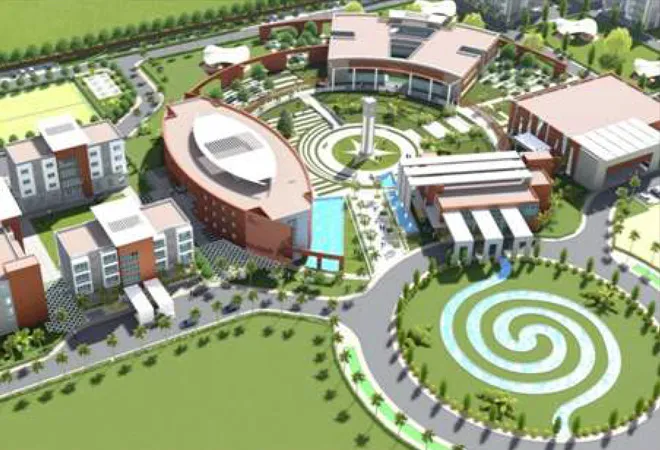-
CENTRES
Progammes & Centres
Location
As urbanisation in India is gathering pace, decentralised and dispersed urbanisation should be adopted by more states

In 2020, the government of Madhya Pradesh commissioned a study to suggest strategies for developing small towns in the state. A study picked a group of five sample small towns viz. Chanderi, Pandhurna, Nagod, Sanawad, and Madhipur, with populations of 33,081; 40,479; 22,568; 38,740 and 34,362 (2011 census), respectively, for the purpose. The selection of towns was based on their spatial distribution within the state to cover all parts. The distinctive characteristics of the towns were also kept in mind so that there was a fair variety in the basket. The Atal Bihari Vajpayee Institute of Good Governance and Policy Analysis, a state government capacity building and research organisation, and the Institute of Social Sciences, New Delhi, carried out the study.
The study collected primary data from these five towns through field studies, followed by a systematic analysis to understand the demographic, economic, social and infrastructure trends. Based on this exercise, the study assessed the developmental potential of the five settlements. These researches were background instruments for two strategies. First, they provided the direction in which small towns could be developed so that they, on their own growth, could contribute to the demographic deceleration of big cities. Second, they enabled the determination of the role of small cities in the context of the state’s urban hierarchy and allowed the synchronisation of the development of large, intermediate and small urban settlements to complement each other.
The study collected primary data from these five towns through field studies, followed by a systematic analysis to understand the demographic, economic, social and infrastructure trends.
The study also looked into the linkages of the small towns with their peri-urban areas and the rural hinterland while eschewing the wholesale transformation of small towns into new entities without affecting their distinctive character. However, it had to focus on goals of sustainability, inclusion and resilience – imperatives for any democratic and modern society, and the survival instruments of the future world in the face of climate change.
Madhya Pradesh is geographically the second-largest state in India and fifth-largest in demography, with 27.63 percent of its population in urban areas. The 2011 census counted 478 towns in the state, accounting for a mere 6 percent of all towns in India. Of the urban population in the state, only 24 percent live in class III towns, having a population from 20,000 to 50,000. The five towns selected for the study have populations between 22,000 and 45,000, geographical areas between 4 sq km and 23 sq km, and population densities between 2,000 and 5,000 per sq km. The study revealed that class III towns did not attract in-migration and that the population from villages migrated directly to the big towns or cities.
Given the explosive growth of just a handful of very large cities, the Government of India tried to prioritise medium and small towns in 1978 through its Integrated Development of Small and Medium Towns (IDSMT) scheme. Its primary objective was to encourage dispersed urbanisation by providing adequate economic, physical and social infrastructure facilities to smaller towns. Three distinct arguments backed the IDSMT.
Despite the clear and sound articulation of goals, the IDSMT scheme had limited success. The Government of India’s investments in the scheme remained feeble and disjointed to make any significant impact on the growth of medium and small towns.
Planned development of open spaces, parking spaces and informal units for vendors, as per norms, shall improve walkability and visual effect of the streets.
In light of the above experience, the present study recommended a reasonable level of productive government spending. These could include local orphanages, old age homes, recreation centres, prisons, technical colleges or tourist facilities. All these services would lead to direct or indirect employment or purchasing power. Significantly, such expenditure was to be in addition to the normal “consumption” infrastructure, such as water, sanitation, and housing. Furthermore, private capital must be encouraged in manufacturing, retail and services to create additional jobs and opportunities. The comparative advantages of such towns in agriculture, tourism, agri-processing, social services, and commerce needed to be analysed. More quality schools with greater infrastructure and better health facilities, such as government dispensaries, were equally vital.
None of the five selected small towns had prepared their development plans (DP). The study was categorical that such towns needed to ready their twenty-year master plans and revise them as per schedule. They must follow Urban and Regional Development Plans Formulation and Implementation (URDPFI) Guidelines recommended by the Ministry of Urban Development, Government of India, to have a semblance of uniformity within the country. Planned development of open spaces, parking spaces and informal units for vendors, as per norms, shall improve walkability and visual effect of the streets. They also needed to appoint a minimum of one certified town planner each to oversee the implementation of the DP and assist the town in urban planning. Ensuring the enforcement of building bye-laws was critical to urban development. This would help keep unauthorised construction in check and avoid narrow streets between the unorganised plots and layouts lacking setbacks.
Migration towards big cities is due to their superior employment opportunity, better service delivery and superior physical and social infrastructure compared to small towns and villages.
The study admitted that the development of ‘small towns’ globally and nationally is a relatively underdeveloped sphere of research. However, it referred to the advice offered by the United Nations to countries to decelerate the urban population growth rate and the emergence of large cities as a distinct phenomenon. While the wisdom of slowing down the rate of urbanisation may be disputed in light of the economic growth that urbanisation promotes, the UN’s advice on limiting the size of large cities remains sound. Migration towards big cities is due to their superior employment opportunity, better service delivery and superior physical and social infrastructure compared to small towns and villages. Small towns, however, have an additional role other than in redistributing the urban population. If appropriately aided, they could catalyse the development of rural regions and equitably distribute the benefits of urbanisation.
Given that urbanisation in India is gathering pace, decentralised and dispersed urbanisation is vital for its urban health. This will ease pressure on the large cities and distribute economic productivity over many towns and villages. This has been a recommendation since the National Commission on Urbanisation (1988) identified over 300 such towns for engagement. However, such urban settlements would not be able to contribute to the urban dispersal process unless they are aided through a robust investment programme of the government in economic, physical and social infrastructure backed by private investment in manufacturing, retail and services. This mechanism should be possible as plentiful land is available at affordable prices. It is also insufficient that such strategies are evolved by only a single state. All states should ideally carry out a similar exercise to create many more economically viable, liveable and dispersed urban destinations.
The views expressed above belong to the author(s). ORF research and analyses now available on Telegram! Click here to access our curated content — blogs, longforms and interviews.

Dr. Ramanath Jha is Distinguished Fellow at Observer Research Foundation, Mumbai. He works on urbanisation — urban sustainability, urban governance and urban planning. Dr. Jha belongs ...
Read More +